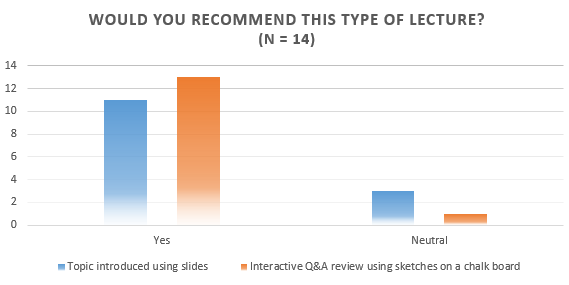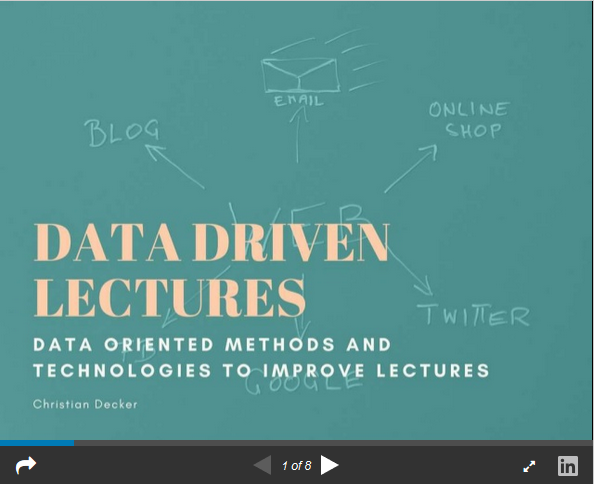tl;dr - What are Data Driven Lectures?
Radio interview on my data instruments (lang = ger)

Intro
Data Driven Lectures (DDL) aim at a continuous progress and quality monitoring of my lecturing activities through the use internet technology. Students attending my lectures use their smartphones, tablet, and laptops to provide feedback on various aspects of a lecture, which enables me to incrementally adapt and improve my lectures. Collected evaluation results display positive effects on balancing material covered, learning speed and effort.
I have implemented Data Driven Lectures within the BSc. Business Informatics program at the Reutlingen University.
Data Instruments and Key Statistics
I have deployed the following instruments in my data driven lectures. At the semester start, I inform the students on each instrument’s objective and usage. All instruments are free of charge and students do not require accounts when using them.
| Instrument | Objective | Implementation | Statistics |
|---|---|---|---|
| Kanban Lecture | provide overview and progress in a kanban-alike style, support students’ time management | trello.com | Access statistics |
| Retrospectives | students propose concrete and contructive changes for the lecture | Starfish method form agile SW development implemented as Google form | Feedback provided |
| Live Opinion Polls | yes/no poll, fast, use often, only for trend analysis | QR code accessible Google form | Trend |
| Social Media | inform students about current events in their field, create an eco system | Twitter, Facebook and others | Top Tweets |
During a lecture I regularly refer students to use the feedback intruments. Every week, I check the key statistics of each intrument in order to prepare the next chapter of the lecture.
Use Case: Live Opinion Polls
I demonstrate a spontaneous use case of opinion polls during a lecture. At the beginning of each lecture, I begin with a quick review of the last lecture’s topic. Usually, I change the presentation media. While the topic was introduced with slides previously, during the review I utilize a chalk board and intensive Q&A with the students.
In the lecture on computer networks, we deeply looked into ARQ protocols for reliable data transfer using slides and simulation. I was interested, whether the review’s change in the presentation style was perceived positively by the students. I performed a quick poll before and after the review. Students raised their smartphones and tablets and accessed the opinion poll form via QR code. The figure below depicts the results for n=14 particpating student. Poll was conduted on Dec. 7, 2017.

To conclude: Students positively acknowledged the review with its changed presentation style. I will continue with this kind of structure in my lecture.
Smart Environments
I am pushing the approach forward and have advanced the concept to create Smart Environment for Teaching and Learning. This is a classroom embedding various Internet-of-Things (IoT) technologies and therein connects lecturing and learning activities directy. It perceives the current situation of all attending students and enables immediate feedback and control on breaks, progress and pace of a lecture. We have implemented a smart classroom environment within the Services Computing Masters program at the HHZ.
This work is part of ongoing research. Check out Smart Environments for further information.

